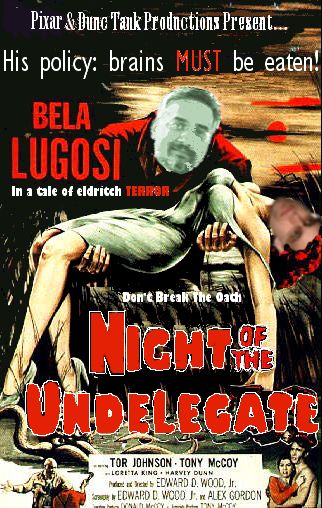Open Source @ Consolidated Braincells Inc.
This is a weblog I'm keeping about my work on Debian and any other useful Debian related info I come across. It is not meant to compete with other news sources like Debian Weekly News or Debian Planet. Mostly it is just a way for me to classify and remember all the random bits of information that I have floating around me. I thought maybe by using a blog it could be of some use to others too. Btw. "I" refers to Jaldhar H. Vyas, Debian developer for over 8 years. If you want to know more about me, my home page is here.
The name? Debain is a very common misspelling of Debian and la salle de bains means bathroom in French.
If you have a comment to make on something you read here, feel free to write to me at jaldhar@debian.org.
You can get an rss 0.91 feed of the blog here.
Is The Rectum A Text? ← Actual Modern Language Association conference paper. (Though apparently the contents aren't the cliché you might expect from the title.)
See also
One of Don Marti's predictions for 2007 is "Increased Support Offerings for pure Debian" It's a nice thought but I don't see it happening. While Debian is technically excellent how many organizations are going to want to hold their business hostage to a thousand prima donnas moaning about their motivation or lack thereof? No my prediction is that 2007 will continue the present trend of derivatives using Debian as a solid foundation while bypassing the dysfunctional aspects of our culture and adding what Debian can't or won't provide.
All though I don't celebrate it myself, I am not one of those tedious people who get all bent out of shape because someone wishes them a merry Christmas. In fact growing up in a small village in England, I used to play the Three Wise Men in my schools Nativity play. It was a very small village.
My DateTime::Calendar::Discordian perl module (Also available as a Debian package.) is todays entry in the Perl Advent Calendar.
Venkatesh Hariharan recently wrote an article on Indias traditions of knowledge and how Open Source meshes with them. Now having met him at foss.in and knowing of his work, I am 100% convinced he is on the side of the angels and their is no malice in what he wrote. However, his interpretation (really not his, but the conventional wisdom amongst the Indian elite.) of Indian history and culture is so monumentally wrong it bears correction. While I admit my hackles were raised by the cultural and theological mistakes made, there are implications for Open Source advocacy in India and the world at large too.
He starts by giving the example of Nalanda, supposedly "the first university in the world." but more accurately a Buddhist vihara (monastery.) Its' very name indicated sharing. I use the past tense because Nalanda doesn't exist anymore. In fact except in a few border areas influenced by Tibet or Burma, Buddhism itself is so thoroughly extinct in the land of its birth, the place where it flourished for over 1500 years, that the only reason people like Hariharan or myself only know that there ever was such a thing due to the work of 19th century Western Indologists. How could this be? One theory is that a resurgent Hinduism coopted or persecuted the Buddhists into oblivion. However this is unsatisfactory. It does not explain why Jainism (a religion as old as Buddhism and equally heretical for exactly the same reasons from the Hindu point of view) still survives to this day and it doesn't explain how it could have happened for even the most advanced genocidal regimes of the 20th century have been unable to "disappear" undesirables to the extent which Buddhism disappeared.
A more plausible explanation revolves around the fact that, as I mentioned before, places like Nalanda were Viharas. This doesn't mean that they can't have university-like properties too; after all the great academic institutions of Europe also had religious foundations but the monastic nature of a vihara is salient. A monastery is not a place you go to engage the world, its a place you go to escape it. To mix metaphors a bit, the viharas were cathedrals not bazaars. While there may have been a lively intellectual life within its walls, there is no evidence that Nalanda and its denizens interacted much with the surrounding culture. An economically unproductive institution of such vast size (15,000 monks at its peak) could only survive by the patronage of kings and other rich people. When that patronage dried up as for example when the medieval Muslim invasions swept away the old royalty, Nalanda and its sisters couldn't survive. Just as when a proprietary software company dies, its "intellectual property" often dies with it, when centralized Buddhism died, Buddhist ideas died with it. (Luckily Buddhism had spread to other countries by then and developed new, less monolithic forms so it was not lost to the world altogether.)
In contrast Hinduism (and for that matter Jainism) while having all due respect for monks were and are primarily lay movements. The pursuit of morality (Dharma), wealth (artha) and pleasure (kama) in this world are equally valid human goals alongside liberation from the world (moksha.) and this manifested as the much maligned institution of caste. Hariharan quotes the conventional view probably familiar to Westerners from Anthropology 101, a lock-step hierarchy of four classes (varna is the Sanskrt word) with fixed occupations, with knowledge and privilege on top and ignorance and oppression at the bottom. The thing is, this view bears no relationship whatsoever with social reality in India now or historically. There is another Sanskrit word, jati, which can be translated as caste. There are thousands of these jatis and while Indian thinkers have periodically attempted to try and shoehorn them into the varna framework, they have had little success and varna is for all practical purposes just a theory. And this is not just a fall from some putative golden age (Like the canard that once caste was flexible and merit based and only later became rigid.) but the state of affairs throughout recorded history.
A jati consists of people who share a common (or fictive) kinship, who have particular food and ritual choices, and marry endogamously. While many jatis are associated with a particular occupation, many others are not. This is what caste means to a typical Indian (it is also the social organization prevalent amongst Jains, Sikhs, Muslims and Christians even if they don't accept its theological basis.) Yes, hierarchy and concommitantly oppression, are in some cases a byproduct of casteist thinking but they are hardly its raison d'etre. A comparison can be made to the Western nuclear family system. Some people think it is superior to any other form of social organization. Most people wouldn't go that far but go along with it as "the way it is." Some of those of a liberal persuasion might want tweaks of certain aspects of it. A very small fringe think it is nothing more than a nefarious plot to spread patriarchy, subjugation and racism etc. They are mostly considered kooks by the other groups. (Unfortunately when India and caste are concerned, the kooks are ruling the roost.) The diversity of jatis like the diversity of open source creates a certain resistence to disruption that a monoculture cannot. Thus though Hinduism also suffered grievously from invasions, it was able to hold on where Indian Buddhism could not.
Brahmin (sic. That's an English mispronounciation.) is also misinterpreted as one who knows Brahma (masculine noun. The Creator God.) instead of Brahman (neuter noun. The supreme spirit pervading the Universe.) though even then it would be wrong because Brahmin, Brahma, and Brahman all come from a common root word brhati (feminine noun. Sacred speech.) as any Sanskrit dictionary will attest.
Hariharan cites the example of the sacred scriptures (Sic. He means the Vedas) and the notorious statement of the Manusmrti saying that an unqualified person who hears them should have molten lead poured into their ears as examples of the proprietarization of knowledge. Now the long-suffering untouchables may have been afraid of many things but having lead earplugs was not one of them. There is no historical evidence that any such action was ever attempted. You can criticize the Manusmrti for even saying such a thing but that is a far cry from using it as evidence of historical attitudes. You see, the Manusmrti is not even in the most orthodox conception Hindu Sharia and the Vedas are not "Sacred Scriptures" in the sense that the Bible or Koran are. Rather they are part of a wide range of significant literary works respected in Hinduism of which other important examples are the two Epics the Mahabharata (which includes the Bhagavadgita), and the Ramayana, and the vast compendia of geneologies, philosophy, lore and legend called the Puranas. Hariharan actually missed a good chance to make his point here because while the Vedas are indeed "proprietary" the other works I mentioned are not and have in fact permeated all over India and even beyond its borders. Many Indian languages owe their literary existence to translation of the epics or Puranas. For instance one of the earliest monuments of Hindi literature is the Ramacharitamanasa, Saint Tulsidas's translation of the Ramayana. When he wrote it in the 16th century, he did face some opposition from those who didn't think such an august work should be rendered into a "vulgar" tongue, he also received encouragement from equally orthodox people (including those who believed the Vedas should be restricted to Brahmins) Today it is by many accounts the most popular Hindu holy book in existence. So really the whole idea that the Hindu canon shows a fall from open grace to rigidly controlled private property is just bogus.
To those who have slogged their way though all this verbiage wondering what it has do with Linux and Open Source, let me assure you I am getting to the point :-) It's bad enough from my point of view as a devout Hindu that my religion would be misrepresented this way but from my point of view as a supporter of Free Software ideals, it is catastrophic.
Linux and Open Source in India has spread, as in most parts of the world, primararily as a hobby amongst computer enthusiasts and for a hobby it's doing ok. However if you think of it as more than that, as a tool to enhance society and empower peoples lives, that is not nearly good enough. But how can one serve a society if one apparently has no clue about that societies history and mores? The developing world is littered with failed projects that were carried out with the purest of motives but no regard to what the putative clients actually wanted. Do we want Linux and Open Source deployments to go the same way?
For a couple of years now I've been trying to get Indian and NRI programmers to get involved in localization in debian-installer and elsewhere but even with the small minority that are sympathetic to Open Source (a scandal in itself.) it is like pulling teeth. To their credit, Red Hat India pays people to work on such things but volunteerism is the heart of the Open Source movement as we all know so the apathy of Indian IT professionals is deeply troubling. Hariharan is trying to increase interest by appealing to the Indians' sense of cultural pride which is a good tactic--it has been successfuly applied by many non-western or minority cultures--but he is not going to be very successful if the vision of Indian culture he is presenting is as alien as Eskimo culture to the vast majority of the people.
Western Open Source advocates also run into difficulties due to being tone-deaf in their understanding of how third-world cultures actually operate. When India declined to participate in the One Laptop Per Child (OLPC) project, some commentators on places like Slashdot were perplexed. Wouldn't a poor country want an inexpensive yet efficient pc using free software instead of high-priced imports? The thing they missed is that while people in India may be poor, thanks to a more-or-less democratic polity and more-or-less open communications, their frame of reference is no longer their village. Their trends are increasingly set in Mumbai, New York, Paris, and London. The forward-thinking amongst them know that computers are the key to the future. They also know Bill Gates is the richest man in the world thanks to something called "Windows" knowing which can get you a green card and your own chance of becoming rich. So if Linux comes along, presented as a cheap alternative which is "just as good", the fake Gucci handbag of IT if you will, it is not going to impress. Thinkpads and Dells appeal to the upwardly-mobile persons vanity, a third-world hand-cranked laptop does not. (This incidently is what is behind the "Nalanda university" meme too. Monasteries are yesterday. Universities are the in thing so we have to have some in our past and not just any but by golly, the first university in the world.)
When they venture from pure technology into the realm of culture, Open Source advocates need to be a lot more sophisticated, not to mention accurate, in their arguments lest they fall on deaf ears. Platitudes and sentimentality about "spiritual" versus "material" culture aren't enough. There must be concrete demonstrations of the benefits of why the Open Source approach to knowledge is better. They must be more sensitive in their presentation to avoid needlessly antagonizing people who might otherwise be natural allies. I believe the Open Source ideal is good for India and the whole world, not just in software but for society at large and I wish Venkatesh Hariharan and all the others on the frontlines of the fight for openness the best of luck. But good intentions cannot excuse sloppy thinking.

..and visit Lake Jvyasjärvi. When I visited Finland for Debconf 5 I was hoping I would make a favorable impression on the locals but really guys, thankyou but this is too much. I'm blushing!

Technical note: I switched from the GIMP to krita for this picture. Overall I'm impressed, krita has a good selection of features and a much better interface thsn the GIMP. However some filters still cause it to crash.

IS THE BUTT A MUSCLE? == === ==== = ======= - - -=-=-=-=-=- Don't Delete Anything Between These Lines =-=-=-=-=-=-=-=- 456174-6D6F7265-66616C6166656C [ ] Choice 1: Yes [needs 3:1] [ ] Choice 2: No [ ] Choice 3: Further discussion - - -=-=-=-=-=- Don't Delete Anything Between These Lines =-=-=-=-=-=-=-=-
Faro points out that the map of Spain in my previous post is obsolete. A more uptodate version can be found here.
From that link I also discovered that calling Extremadura a province is wrong. It is an "Autonomous Community" which consists of two provinces: Badajoz and Cáceres. The latter is where the place we were staying, Casar de Cáceres, is located.
previous page [1] [2] [3] [4] [5] [6] [7] [8] [9] [10] [11] [12] [13] [14] [15] [16] [17] [18] [19] [20] [21] [22] [23] [24] [25] [26] [27] [28] [29] [30] [31] [32] next page